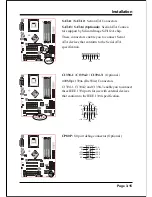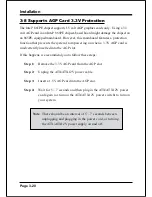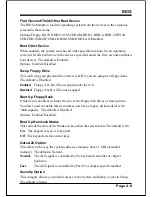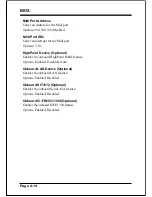
BIOS
Page 4-5
First /Second/Third/Other Boot Device
The BIOS attempts to load the operating system from the devices in the sequence
selected in these items.
Options: Floppy, LS120, HDD-0, SCSI, CDROM, HDD-1, HDD-2, HDD-3, ZIP100,
USB-FDD, USB-ZIP, USB-CDROM, USB-HDD, LAN, Disabled.
Boot Other Device
When enabled, the system searches all other possible locations for an operating
system if it fails to find one in the devices specified under the first, second, and third
boot devices. The default is Enabled.
Options: Enabled, Disabled.
Swap Floppy Drive
This will swap your physical drive letters A & B if you are using two floppy disks.
The default is Disabled.
Enabled
: Floppy A & B will be swapped under the O/S.
Disabled
: Floppy A & B will be not swapped.
Boot Up Floppy Seek
If this item is enabled, it checks the size of the floppy disk drives at start-up time.
You dont need to enable this item unless you have a legacy diskette drive with
360K capacity. The default is Disabled.
Options: Enabled, Disabled.
Boot Up NumLock Status
This controls the state of the NumLock key when the system boots. The default is On.
On
: The keypad acts as a 10-key pad.
Off
: The keypad acts like cursor keys.
Gate A20 Option
This refers to the way the system addresses memory above 1 MB (extended
memory). The default is Normal.
Normal
: The A20 signal is controlled by the keyboard controller or chipset
hardware.
Fast
:
The A20 signal is controlled by Port 92 or chipset specific method.
Security Option
This category allows you to limit access to the System and Setup, or just to Setup.
The default is Setup.
Summary of Contents for DDR266 (PC2100)
Page 6: ...Page Left Blank ...
Page 13: ...Introduction Page 1 7 Figure 5 System Block Diagram System Block Diagram ...
Page 14: ...Introduction Page 1 8 Page Left Blank ...
Page 19: ...Installation Page 3 1 Section 3 INSTALLATION ...
Page 20: ...Installation Page 3 2 Mainboard Layout ...
Page 82: ...Appendix B 2 Page Left Blank ...
















































